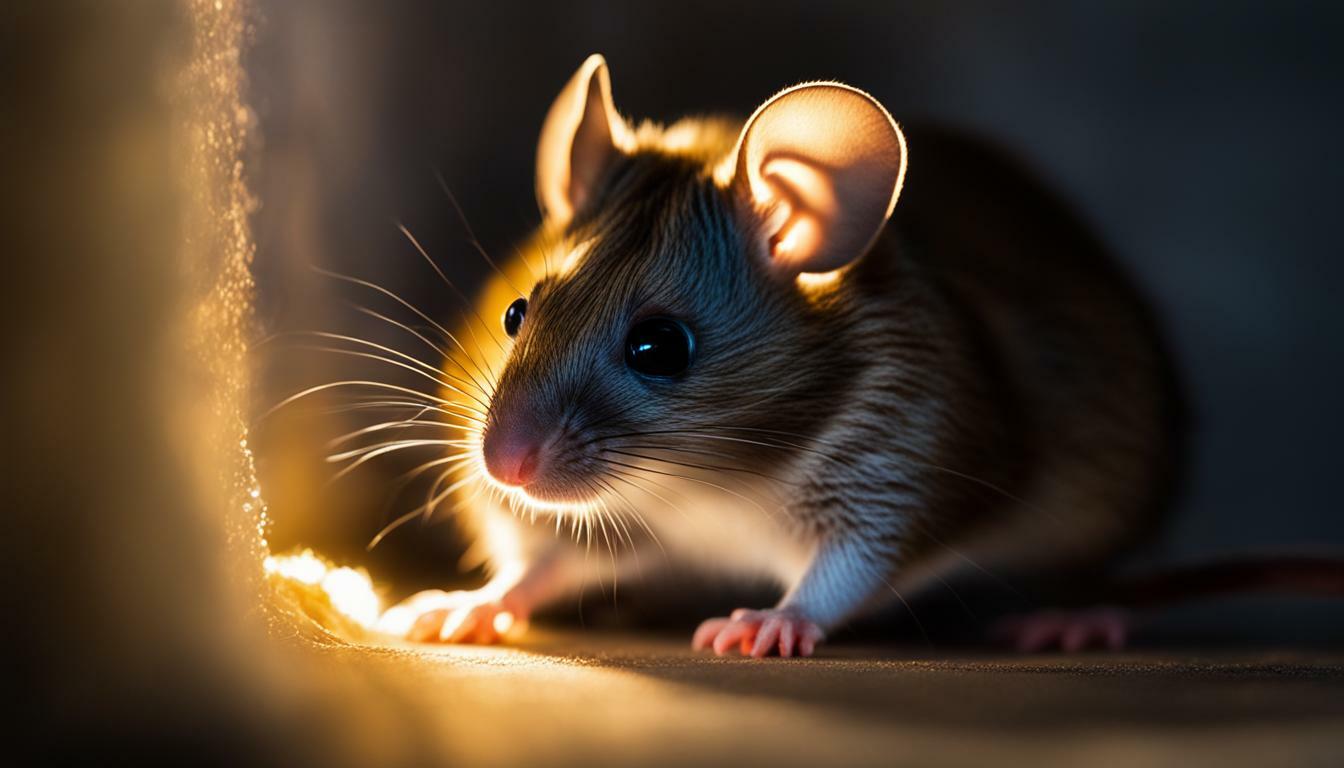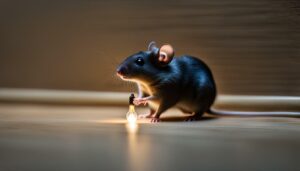Are you curious about what color light do mice hate and how it can help you keep these furry intruders at bay in a humane way? It turns out that mice are sensitive to different colors of light, and certain colors can have an effect on their behavior. By understanding which light colors mice tend to avoid, you can use rodent repellent lights as a natural deterrent.
Key Takeaways:
- Mice are sensitive to different colors of light
- Blue light stimulates mice, while green light induces sleep
- LED lights and bright lights can deter mice
- Ultraviolet light is effective in repelling mice
- Combining colored lights with other repellent methods can increase effectiveness
Understanding the Effects of Different Light Colors on Mice
To understand what color light mice hate, it’s important to delve into the effects different light colors have on their behavior. Mice are sensitive creatures, and certain colors of light can have a notable impact on their actions and emotions.
A study on light and mouse behavior found that blue light has a stimulating effect on mice, increasing their activity levels. On the other hand, green light induces sleep in mice, making them more likely to rest. Interestingly, both green and blue lights were found to elevate stress hormone levels in mice compared to being in the dark.
When it comes to repelling mice, red light has shown low effectiveness. Blue light, on the other hand, has been rated as highly effective in deterring these rodents. This makes it a valuable option to consider when choosing mouse deterrent lights.
In addition to specific colors, the intensity of light also plays a role in repelling mice. LED lights and bright lights in general create an uncomfortable environment for mice, making them less likely to stay or enter a space. Flashing lights or strobe lights can further enhance this effect.
Effects of Light Colors on Mice:
| Color | Effect |
|---|---|
| Blue | Stimulates mice, increases activity levels, rated as highly effective in deterring mice |
| Green | Induces sleep in mice, elevates stress hormone levels |
| Red | Low effectiveness in repelling mice |
It’s important to note that while colored lights can be effective in repelling mice, they should be used in combination with other repellent methods for maximum effectiveness. Mice also have a strong sense of smell, so incorporating scents like peppermint oil or vinegar may further enhance the repellent effect.
In conclusion, understanding the effects of different light colors on mice can help in creating an environment that these rodents find unappealing. By choosing the right colors and intensities, along with additional repellent methods, you can effectively deter mice from entering your space.
The Effectiveness of Light Colors in Repelling Mice
When it comes to repelling mice, certain light colors have shown greater effectiveness than others. Let’s explore which colors are most likely to deter these pesky intruders.
A study conducted on the effects of different light colors on mice found that blue light stimulates them, while green light induces sleep. Interestingly, both blue and green lights were found to elevate stress hormone levels in mice compared to being in the dark. This suggests that these colors create an uncomfortable environment for the rodents, making them less likely to venture into spaces illuminated by blue or green lights.
On the other hand, red light was found to have a low effectiveness in repelling mice. This could be attributed to the fact that red light has longer wavelengths, making it less stimulating and potentially less bothersome to the rodents. Based on the study’s findings, it is clear that blue light is highly effective in deterring mice, while red light may not have the same repellent effect.
In addition to specific light colors, the intensity of the light is also a factor to consider. LED lights and bright lights, in general, can create an uncomfortable environment for mice due to their brightness. Furthermore, flashing lights or strobe lights can further enhance the repellent effect as they disrupt the rodents’ surroundings and make it challenging for them to navigate comfortably.
In conclusion, certain light colors have been shown to be effective in repelling mice. Notably, blue light has been rated as highly effective, while red light has shown lower effectiveness. LED lights and bright lights can also contribute to deterring mice. However, it’s important to remember that light colors should be used in combination with other repellent methods for maximum effectiveness. Additionally, mice have a strong sense of smell, so using other scents like peppermint oil or vinegar may also be helpful in keeping them at bay. By implementing a multi-faceted approach, you can create an environment that mice find unappealing, reducing the likelihood of these unwanted guests in your space.
| Light Color | Effectiveness in Repelling Mice |
|---|---|
| Blue | Highly effective |
| Green | Effective |
| Red | Low effectiveness |
Other Factors to Consider in Mouse Repellent Strategies
While colored lights can be effective in repelling mice, it’s crucial to consider other factors to enhance your mouse repellent strategies. Ultraviolet light, for example, has shown promising results in repelling mice. These rodents are sensitive to ultraviolet rays, which can create an uncomfortable environment for them. Consider adding ultraviolet lights in strategic areas known to attract mice, such as entry points or dark corners.
In addition to colored lights, scents can play a significant role in deterring mice. Mice have a strong sense of smell, and certain scents can repel them effectively. Peppermint oil, for instance, is known to be highly disliked by mice. Soak cotton balls in peppermint oil and place them near areas where you suspect mice activity. The strong scent will act as a natural repellent and discourage mice from venturing into your space.
Another scent that can help to repel mice is vinegar. The strong acidic smell of vinegar is unpleasant for these rodents and can deter them from entering your home. Create a mixture of equal parts vinegar and water and spray it in areas prone to mice infestation, such as dark corners, basements, or storage spaces.
| Mouse Repellent Methods | Effectiveness |
|---|---|
| Colored Lights | Moderate |
| Ultraviolet Lights | High |
| Peppermint Oil | High |
| Vinegar | Moderate |
It’s important to note that no single method can guarantee complete mouse repellent success. Combining different strategies, such as colored lights, scents, and other measures, will increase your chances of effectively repelling mice from your space. Keep in mind that mice are highly adaptive creatures, so using a multi-faceted approach will help prevent them from getting accustomed to any single deterrent.
Conclusion
In conclusion, understanding the light colors that mice dislike can be a valuable tool in your efforts to keep these pests at bay. A study has shown that mice have different reactions to different colors of light, with blue light stimulating them and green light inducing sleep. Additionally, green and blue lights have been found to elevate stress hormone levels in mice compared to being in the dark.
When it comes to repelling mice, certain light colors have proven to be more effective than others. For instance, red light has a low effectiveness in repelling mice, while blue light has been rated as highly effective. LED lights and bright lights, in general, can also serve as deterrents for mice, while flashing lights or strobe lights can create an uncomfortable environment for them.
It’s important to note that colored lights should be used in combination with other repellent methods for maximum effectiveness. Mice have a strong sense of smell, so incorporating other scents like peppermint oil or vinegar can enhance the repellent effects. Additionally, ultraviolet light has shown to be effective in repelling mice, making it another option to consider in your mouse repellent strategy.
By implementing a multi-faceted approach that combines the use of light colors, scents, and other repellent methods, you can create an environment that mice find unappealing. This holistic approach will significantly reduce the likelihood of these unwanted guests in your space, allowing you to maintain a pest-free environment.
FAQ
What color light do mice hate?
Mice are sensitive to different colors of light. Some colors that mice dislike include blue, green, and yellow. Ultraviolet light is also effective in repelling mice.
How do light colors affect mice?
Different light colors have been shown to have varying effects on mice. Blue light stimulates mice, while green light induces sleep. LED lights and bright lights, in general, can deter mice. Flashing lights or strobe lights create an uncomfortable environment for them.
Which light colors are effective in repelling mice?
A study found that blue light was highly effective in repelling mice. Red light had low effectiveness. It’s important to note that colored lights should be used in combination with other repellent methods for best results.
Are there other factors to consider in mouse repellent strategies?
Yes, besides light colors, other factors to consider include using ultraviolet light as a repellent and incorporating scents like peppermint oil or vinegar. A multi-faceted approach is recommended for maximum effectiveness.
Why is it important to use a combination of repellent methods?
Combining light colors with other repellent methods ensures a holistic approach to keep mice away. Mice have a strong sense of smell, so using scents in addition to light colors can further deter them.




